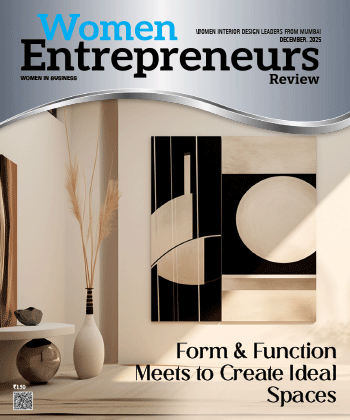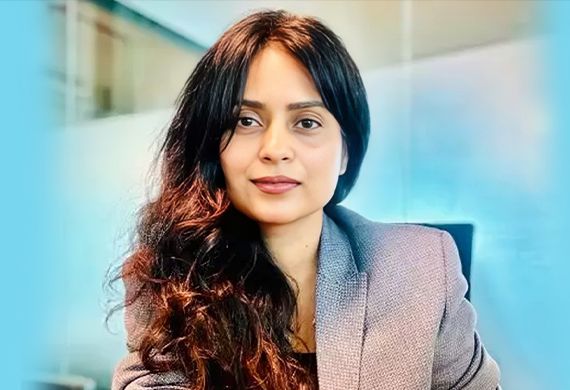
From Roots to Retail: This Woman Entrepreneur is Crafting a Greener Future for Children's Fashion
By: Shambhavi Jaiswal, Founder, MULYO KIDS
Sustainability has become a buzzword today, with brands across the world jumping on the bandwagon to attract modern, climate-conscious consumers. But long before sustainability became a global trend, India had been living it. Ask entrepreneur, Shambhavi Jaiswal, about the seed of the idea to establish a sustainable kids wear brand, and she takes us back to her maternal grandparents’ home, where she spent time surrounded by sustainability being the way of life. She says, “Sustainability wasn’t a strategy for me, it was something I carried in my bones. A quiet influence that began in my childhood, at my maternal grandparents’ home. That place was alive in the truest sense. Plants climbed walls, grew out of cracked cement floors, and filled every corner with green. Nothing was wasted. Everything had a purpose. Even the smallest patch of soil gave something back.”
Inspired by these early experiences, an understanding of fashion’s detrimental impact on waste generation, and a wealth of experience gathered over the years in the fashion retail market, Shambhavi founded MULYO KIDS in 2023.
Driven by her passion for ethical fashion and environmental responsibility, she is powering her vision to transform children's fashion in India. Having overcome significant challenges, ranging from sourcing eco-friendly materials to building an ethical yet affordable supply chain, her resilience and advocacy have positioned MULYO KIDS as a coveted brand, earning recognition at platforms like Bharat Tex 2024 and support through the Startup India Seed Fund Scheme.
In a recent conversation with the Women Entrepreneur Review team, Shambhavi shares her journey as an entrepreneur, shedding light on her vision, operations, and future plans for MULYO KIDS.
Here are choice excerpts from the conversations.
How was the seed of the idea sown for establishing a sustainable fashion label for children? How did the idea evolve and finally take shape as the brand MULYO KIDS?
The idea of MULYO KIDS started with a strong desire to create mindfully. I had initially planned to launch a women’s wear label, but during my research, both primary and secondary, I came across a surprising insight: kids' wear generates massive textile waste because children outgrow their clothes every few months. That finding changed everything.
I realised that if we want to build a better fashion future, we need to start young. That’s where the seed for MULYO KIDS was sown. I began exploring sustainable materials, understanding parents' needs, and connecting with local artisans. Every step was rooted in purpose.
What started as a simple idea slowly shaped into a brand committed to mindful clothing for children that is playful, ethical, and built to last. MULYO isn’t just about dressing kids, it’s about shaping a more thoughtful, conscious future through the clothes they grow up in.
Before turning into an entrepreneur, you were a part of the Indian fashion retail industry as a professional. What key lessons did you learn in the early years of your professional career that prepared you for your entrepreneurial journey?
Before starting MULYO KIDS, I worked in the fashion industry, where I gained hands-on experience in design, production, and brand management. Being part of fast-moving teams taught me how to work under pressure, manage timelines, and think on my feet. I also learned the importance of communication, whether it was with vendors, team members, or clients.
One of the biggest takeaways from that time was understanding how systems work from the inside. It helped me identify gaps in the industry, especially around sustainability and transparency. These insights became the foundation for MULYO.
The discipline, structure, and problem-solving skills I developed then helped me build my own business with more clarity and confidence. It wasn’t just about designing clothes, it was about building something meaningful with purpose and intention.
The fashion industry is one of the major polluters across the globe. Can you tell us about the extent of the challenges posed by fast fashion, etc, in terms of contributing to waste generation?
The more I learned about the fashion industry, the harder it became to look away. Behind the beauty of new collections lies a harsh truth: fashion is one of the biggest polluters in the world. Fast fashion has made it worse, flooding the market with cheap, short-lived clothing that’s worn a few times and then thrown away. Most of it ends up in landfills, sitting there for decades, never breaking down.
What moved me was learning about the waste in kidswear. Children outgrow clothes so quickly, and perfectly good garments are discarded simply because they no longer fit. It felt so heartbreaking, much effort, energy, and material used for something that becomes ‘waste’ in just months.
It’s not just about clothes. It’s about the water being polluted, the workers exploited, and the planet we’re leaving behind. Once you see it, you can’t unsee it. And maybe that’s where change begins with choosing to see, and choosing to do better.
How do you integrate sustainable practices within the brand’s functioning and products?
Sustainability had to be at the heart of the brand. From using biodegradable fabrics and plastic-free packaging to working with artisans and producing mindfully, we do it because it’s the only way that feels true. Because if children are the future, the planet they inherit matters just as much.
Starting a sustainable fashion brand from scratch is no easy feat. Were there any challenges that you encountered in the early stages of building the brand, and how did you overcome them?
Starting a sustainable fashion brand came with its own set of challenges. Sourcing genuinely eco-friendly materials was one of the hardest parts of many claimed sustainability, but very few could prove it. It took months of groundwork and research to find partners who truly aligned with our values. Production was equally tough. Convincing manufacturers to slow down and prioritise thoughtful, planet-first processes in a fast-fashion world demanded resilience and patience.
But these challenges also led to innovation. Today, we’re actively researching the development of bio-materials using coconut husk and textile waste resources, often discarded without a second thought. The idea is to create biodegradable, durable alternatives that can replace synthetic materials across various uses.
The early struggles made one thing clear: real change takes time. But with every thoughtful step, we move closer to a future where design doesn’t come at the planet’s cost, and where sustainability is not a choice, but a way of being.
MULYO KIDS received the Startup India Seed Fund Scheme and was invited to Bharat Tex 2024 by the Ministry of Textiles. How have these recognitions contributed to the brand’s growth and credibility?
Receiving the Startup India Seed Fund was like getting a much-needed shot of espresso for the brand, energising, validating, and just what we needed at the right time. It wasn’t just funding; it was a vote of confidence in our vision to make sustainable kidswear mainstream. It helped us invest in R&D, build a stronger supply chain, and most importantly, breathe a little easier while making big decisions.
Being invited by the Ministry of Textiles to showcase at Bharat Tex 2024 was another surreal moment. Standing among some of India’s finest brands, talking about sustainability in kidswear honestly, I had to remind myself to stop smiling awkwardly and act professional!
Both recognitions have added tremendous credibility. They've opened doors to new collaborations, B2B conversations, and a larger audience that now sees MULYO not just as a passion project but as a serious player in the conscious fashion space.
What is your vision and future plan for the brand MULYO KIDS going forward?
The vision for MULYO KIDS has always been bigger than just creating beautiful clothes, it’s about shaping a more conscious future for children and the planet they’ll grow up in. Going forward, I see MULYO growing into a global name rooted deeply in Indian values of simplicity, respect for nature, and craftsmanship.
We want to scale sustainably, reaching new markets while staying true to our core. That means investing more in innovation, especially in alternative bio-materials from agricultural and textile waste. We're also building a stronger community of artisans and collaborators who believe in mindful creation.
Most of all, I want MULYO to become a brand that children feel proud to wear and parents feel good about choosing. A brand that stands for joy, responsibility, and purpose. Because if we want to raise a generation that cares, we have to start by showing them how care can be stitched into every thread.
Most Viewed
- 1 Women's Health Startup HerMD Closing Doors Amid Industry Challenges
- 2 5 Famous Women in Indian Armed Forces
- 3 Saudi Women No longer Require Male Permission for Clothing Choices, says Prince MbS
- 4 Kolkata Medtech Startup Innovodigm Raises Rs 5.5 Crore Seed Funding Led by IAN Group
- 5 Yamunanagar's Kashish Kalra Honoured after Securing 111th Rank in UPSC Civil Services Exam
- 6 Madurai Appoints Its First Woman Corporation Head
- 7 IAS Vijayalakshmi Bidari Appointed as the new Nagpur Divisional Commissioner
- 8 American Entrepreneur Lucy Guo Overtakes T Swift to become Youngest Female Billionaire
- 9 ICC Women's World Cup 2025 Trophy Showcased at Indore's Holkar Stadium
- 10 Aparna Saxena's Beauty Venture AntiNorm Launches in India
- 11 Vidya Nataraj Co-Founded BlueStone Jewellery & Lifestyle files IPO
- 12 5 Women Freedom Fighters of India
- 13 Dr. G Krishnapriya appointed as CEO for Trichy
- 14 M3M & Sirona Partner to Introduce Menstrual Hygiene Vending Machines in 15 Locations
- 15 Punjab Govt launches SHE Cohort 3.0 Supporting Tech-led Women Startups
- 16 Indian origin Lawyer, Sweena Pannu appointed as the US New Superior Court Judge
- 17 The Aurora Tech Award recognizes 4 Indian Women-led Startups
- 18 Kerala's Republic Day parade featured an all-female tableau
- 19 Manisha Kabbur Becomes Karnataka's First Woman International Karate Coach
- 20 Director K. S. Ravikumar's Daughter Maalica Ravikumar Launches Life Coaching Company 'Evergrowth Academy' for Women
- 21 Leezu's Raises Pre-Seed Funding to Accelerate Growth in Sexual Wellness Industry
- 22 Sattu: Super-easy summer drink for PCOS gut healing
- 23 Swathi Nelabhatla creates Sitha App, India's First Women-Exclusive Gig Platform
- 24 7 Timeless Female Kathak Dancers & their Iconic Legacies
- 25 Meet 7 Iconic Women Architects of Modern India & their Most Impactful Work
- 26 This Woman-led Insuretech Startup is Helping Bridge the Education Financing Gap in India
- 27 Women Leaders Share Lessons Learnt from India Women's WC Win
- 28 5 Enterprising Women Founders Powering Singapore's Tech & Innovation Landscape
- 29 4 Women. 4 Stories. One Vision for Smarter, Stronger Healthcare
- 30 Global Gender Gap Narrows to 68.8%, But Full Equality 123 Years Away: WEF Report 2025
- 31 Changemakers: 7 Women Entrepreneurs Taking the Make in India Movement Forward
- 32 Meet Lucy Guo, The Youngest Self-Made Female Billionaire Disrupting Tech
- 33 How Women are Driving India's Festive Online Shopping Surge






